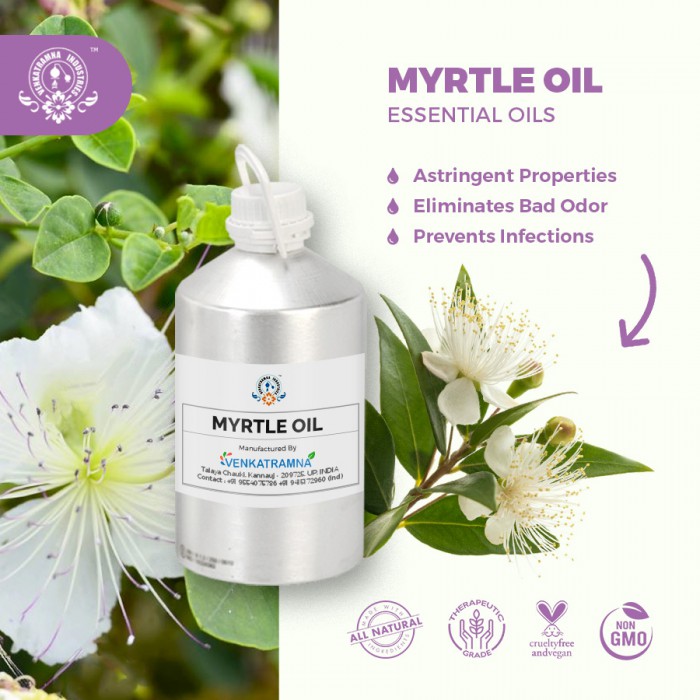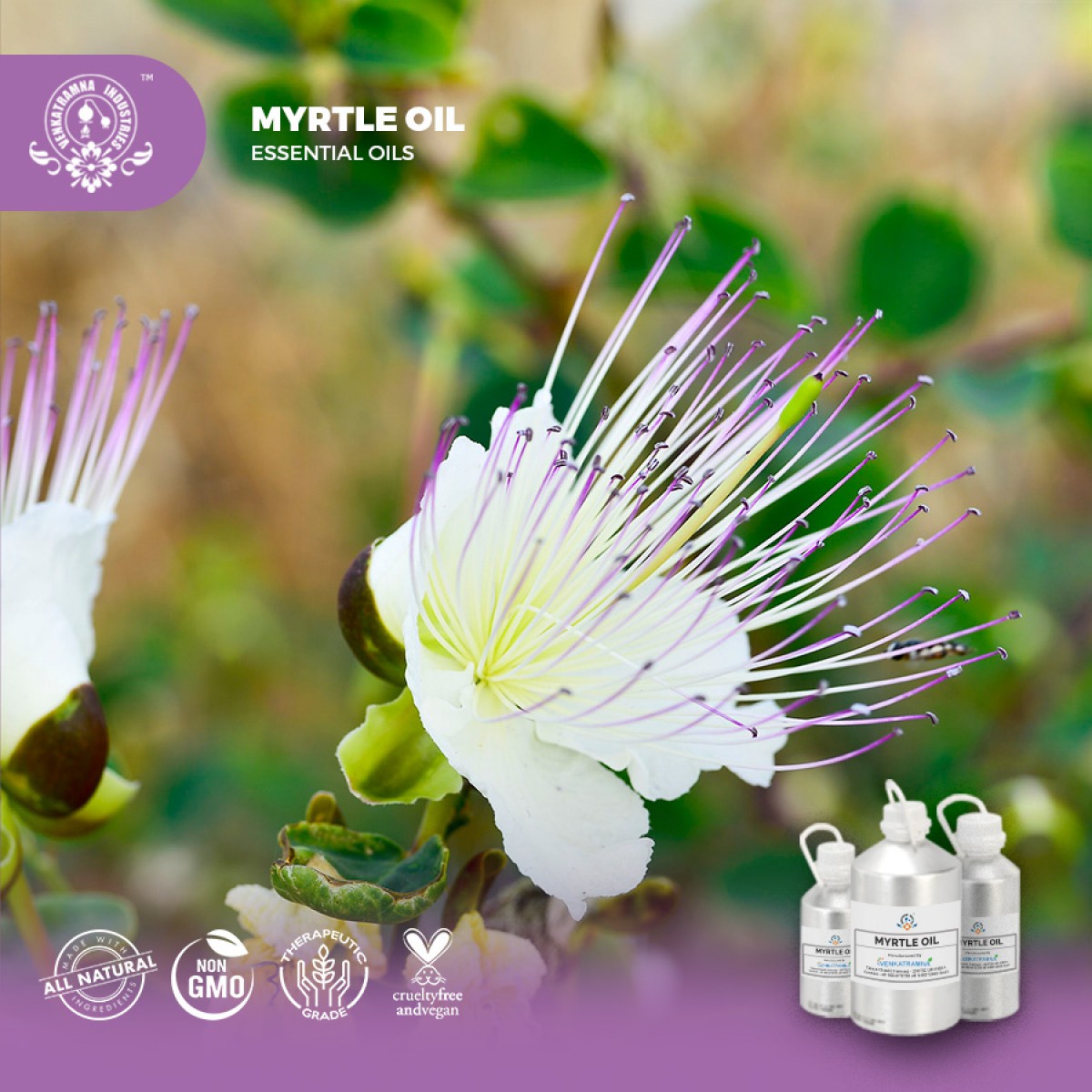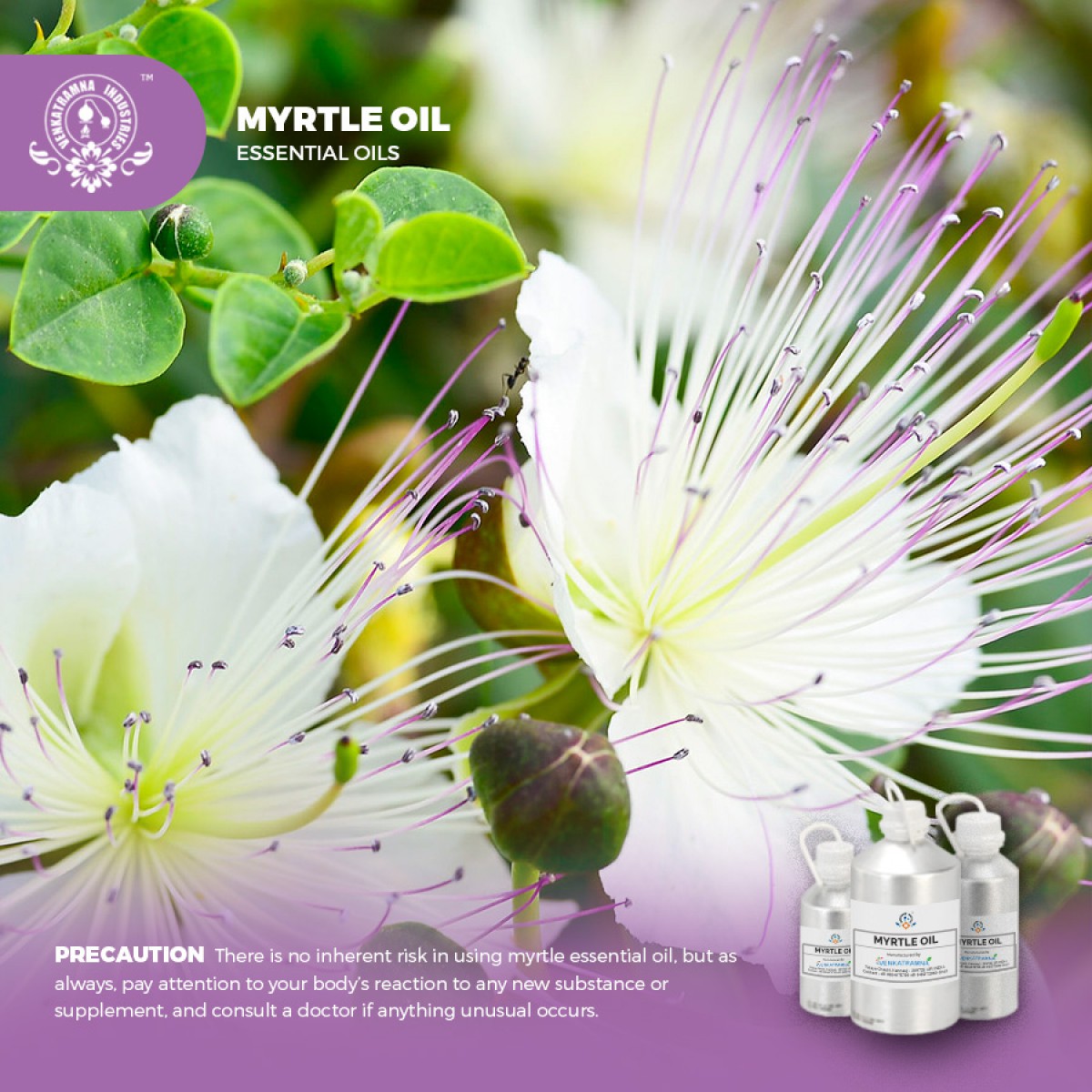Botanical Name: Myrtus Communis Common name: Myrtle, Plant fami Read More
|
Botanical Name: |
Myrtus
Communis |
|
Common name: |
Myrtle, |
|
Plant
family: |
Myrtaceae |
|
Genus: |
Myrtus |
|
Appearance/Color: |
Reddish Brown liquid with thin consistency |
|
Odor: |
Myrtle
Essential Oil has a clear, fresh scent that is mildly camphoraceous, similar
to that of Eucalyptus with medium aroma middle note. |
|
Blends With: |
Benzoin, Bergamot, Elemi, Eucalyptus, Black Pepper, Cedar Wood,
Frankincense, Myrrh, Neroli, Rose, Ho Wood, Hyssop, Jasmine, Lavender, Lemon,
Lemongrass, Clary Sage, Coriander, Melissa, Rosewood, and Ylang-Ylang. |
|
Origin: |
Tunisia |
|
Source: |
Leaves |
|
Method
of Extraction: |
Steam
Distillation |
Myrtus communis, commonly called
myrtle, is a broadleaf evergreen shrub or small tree that is native to the
Mediterranean region. It typically grows to 5-6’ tall but may reach 15-20’ over
time. Pointed, opposite (sometimes whorls), ovate to lanceolate, glossy dark
green leaves (to 2” long) are strongly aromatic when bruised. White aromatic
flowers (3/4”) with many yellow tipped stamens bloom in late spring/summer
(May-July). Flowers are followed by blue-black berries. Berries are edible and
may be eaten raw but are at best moderately tasteful. Dried flowers, leaves and
fruits are used to flavor foods. Leaves are sometimes used as a substitute for
bay leaves. Fresh flowers may be added to salads. Wood and leaves are added to
charcoal to flavor grilled meats.
Myrtle
is an evergreen shrub with fragrant white or pink flowers. It is native to
North Africa but is commonly found in the southern Mediterranean region
including France, Spain, Corsica, Tunisia and Italy. Myrtle essential oil is
steam distilled from the leaves and twigs and sometimes the flowers.
Myrtle is a wild aromatic plant that laboratorial works have demonstrated the insecticidal, antioxidant, anti-inflammatory and antimicrobial activities of myrtle essential oils (EOs). The chemical composition may change according to several factors; nevertheless, it was constant in practically all EOs the presence of 1,8-cineole and ?-pinene, as main components (>5%). The biological activities, generally low or moderate depended on the organism (insecticidal) and microorganism and on the chemical composition. Generally, the contribution of the components on the biological activities was not determined; nevertheless, they were generally attributed to the presence of the main components (1,8-cineole, ?-pinene, eugenol, methyleugenol, myrtenyl acetate, among other components depending on the property). The antioxidant activity of myrtle oil was predominantly determined in cell-free methods, though very few works also used cell model methods. In all cases, the activities were also low to moderate due to the absence of phenol compounds.
DISCLAIMER
The complete range of conditions
or methods of use are beyond our control therefore we do not assume any
responsibility and expressly disclaim any liability for any use of this
product. Information contained herein is believed to be true and accurate however,
all statements or suggestions are made without warranty, expressed or implied,
regarding accuracy of the information, the hazards connected with the use of
the material or the results to be obtained from the use thereof. Compliance
with all applicable federal, state, and local laws and local regulations
remains the responsibility of the user.
The FDA has not evaluated the
statements on this website. No claims are made by Venkatramna Industries as to
the medicinal value of any products from vriaroma.com or by us. The information
presented here is for educating our customers about the traditional uses of
essential oils and is not intended to diagnose, treat, cure, or prevent any
disease. You are responsible for understanding the safe application of these products.
If you have any questions, please call or email us for further information.
As per NAHA guidelines, New Directions Aromatics
(NDA) does not recommend the ingestion of essential oils. It is imperative to
consult a medical practitioner before using Essential Oils for therapeutic
purposes. Pregnant and nursing women and those taking prescription drugs are
especially advised not to use this product without the medical advice of a
physician. The oil should always be stored in an area that is inaccessible to
children, especially those under the age of 7.
Myrtle's leaves and fruits have been widely
used as folk medicine for the treatment of digestive, pulmonary and skin
problems in many parts of the world. Its essential oil, which possesses much of
the healthful properties of the plant, is also popular among aromatherapy
practitioners.
Myrtle essential oil has been used for treating acne, oily skin, and loose pores especially around the Mediterranean even from the Middle Ages (Li et al. 2018; Battaglia 1997), being known as a soft, mild sort of oil with effects for reproduction, convergence, and prevention of allergy. Myrtle essential oil is suitable substance to apply on wounds. It does not let microbes infect the wounds and thus protects against sepsis and tetanus, in case of an iron object being the cause of the damage.
Myrtle essential oil has
clarifying, cleansing, refreshing and uplifting properties. It is said to be an
oil that is emotionally cleansing, curbing self-defeating feelings and
addictions. Myrtle essential oil helps to eliminate foul odors. It can be used
in incense sticks and burners, fumigants and vaporizers as room fresheners. It
can also be used as a body deodorant or perfume. It has no side effects like
itching, irritation or patches on the skin like certain commercial deodorants.
COMMON
USAGE
·
Astringent
Properties
·
Eliminates
Bad Odor
·
Prevents
Infections
·
Expectorant
·
Maintains
Healthy Nerves
·
Relaxes
the Body
·
Aphrodisiac
·
Eases
Breathing
·
Cures
Infections
Ingredients:
|
S.No |
Key Constituents |
Strength (%) |
|
1 |
b-Caryophyllene |
11.0 |
|
2 |
b-Myrcene |
9.5 |
|
3 |
(þ)-Limonene |
7.2 |
|
4 |
d-Cadinene |
4.7 |
|
5 |
a-Caryophyllene |
4.4 |
|
6 |
a-Phellandrene |
4.2 |
|
7 |
Germacrone |
3.7 |
|
8 |
g-Elemene |
3.3 |
|
9 |
a-Cadinolþunidentified |
2.9 |
|
10 |
a-Selinene |
2.6 |
|
11 |
p-Cymene |
2.5 |
|
12 |
(E)-b-Ocimene |
2.3 |
|
13 |
a-Longipinene |
1.7 |
|
14 |
(Z)-b-Ocimene |
1.7 |
|
15 |
Selin-11-en-4-ol |
1.7 |
|
16 |
(E)-Nerolidol |
1.5 |
|
17 |
Caryophyllene oxide |
1.2 |
|
18 |
1,8-Cineole |
1.1 |
|
19 |
a-Bisabolol |
1.0 |
Safety Summary
·
Hazards: Drug
interaction; potentially carcinogenic, based on estragole and methyleugenol
content.
Diabetes
medication.
Maximum
adult daily oral dose 65 mg
Maximum
dermal use level
EU 0.02%
IFRA 0.04%
Tisserand &
Young 1.9%
Safety advice
Recommended maximum adult daily
oral dose of 65 mg for each myrtle oil, based on limits of 0.05 mg/kg/day for
estragole, and 0.01 mg/kg/day for methyleugenol. We also recommend a dermal
maximum of 1.9% for myrtle oils based on either 1.4% estragole and 0.8%
methyleugenol content or 0.2% estragole and 1.0% methyleugenol content, and
dermal limits of 0.12% and 0.02% for estragole and methyleugenol, respectively.
Regulatory guidelines
IFRA recommends a maximum dermal
use level for estragole of 0.01% in leave-on or wash-off preparations for body
and face. IFRA recommends a maximum concentration of 0.0004% methyleugenol in
leave-on products such as body lotions. The equivalent SCCNFP maximum is
0.0002%
Organ Specific Effects
·
Adverse skin reaction: Regulatory guidelines IFRA recommends a
maximum dermal use level for estragole of 0.01% in leave-on or wash-off
preparations for body and face. IFRA recommends a maximum concentration of
0.0004% methyleugenol in leave-on products such as body lotions. The equivalent
SCCNFP maximum is 0.0002%.
·
Cardiovascular
effects: Myrtle oil
reduced blood glucose by 51% in alloxan-diabetic rabbits four hours after an
oral dose of 50 mg/kg, but had no affect serum insulin concentrations.
Systemic Effects
·
Acute
Toxicity: Acute oral LD50
in rats reported as >5 g/kg; acute dermal LD50 in rabbits >5 g/kg. and
3.68 mL/kg . Acute oral LD50 in mice 2.23 mL/kg.
·
Antioxidant/pro-oxidant activity Two
myrtle oils exhibited moderate DPPH scavenging activity with IC50 values of
5.99 and 6.24 mg/mL
·
Carcinogenic/anti carcinogenic potential: Myrtle oil has demonstrated weak-to-moderate
antimutagenic activity. Estragole and methyleugenol are rodent carcinogens;
(þ)-limonene has demonstrated anticarcinogenic activity.
·
Drug
interactions: Antidiabetic medication, because of cardiovascular
effects, above.
Toxicity
·
Acute fish toxicity: LC50 / 96 HOUR – No
data available
·
Toxicity to aquatic plants – No data
available
·
Toxicity to microorganisms – No data
available
·
Toxicity threshold – No data available
·
Persistence and degradability:
Biodegradation is expected
·
Bio-accumulative potential:
Bioaccumulation is unlikely
·
Mobility in soil: Unknown
Avoid exposure to marine environments and waterways





 MSDS-Myrtle1.pdf
MSDS-Myrtle1.pdf




